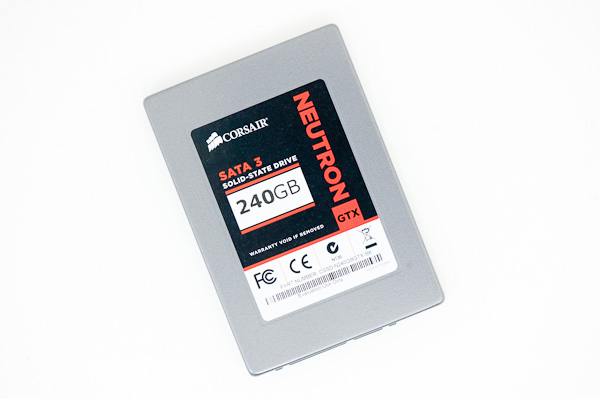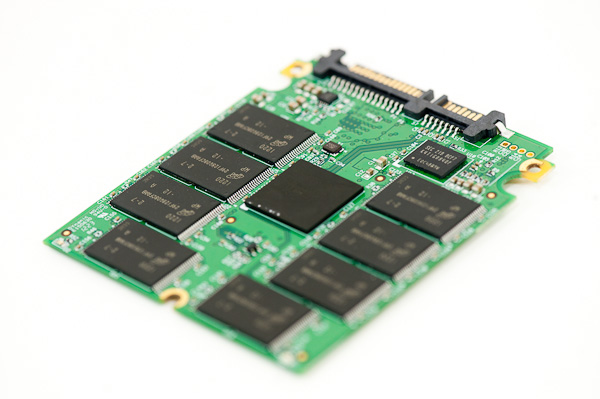Corsair Neutron GTX SSD Review (240GB): Link A Media Controller Tested
by Anand Lal Shimpi on August 20, 2012 6:00 AM EST- Posted in
- Storage
- SSDs
- Corsair
- Neutron
- Link a Media
These are worrying times if you're a traditional PC component vendor. The desktop PC market has been outgrown by notebooks for the past several years, and we're on the cusp of seeing mainstream mobile PCs embrace proprietary component form factors and abandon end user upgradability altogether. I do have faith (or at least hope?) that we'll find some solution to the conflicting desires of upgradability and extreme portability without simply embracing disposable computing, but until then the world is going to keep getting more difficult for those who solely make components that go into a desktop case.
The transition of choice for the past few years was to build SSDs. While still not completely future proof, SSD upgrades are applicable to both desktop and conventional notebooks. Due to an outright failure of the traditional HDD vendors to get in early with solid state storage, smaller SSD vendors had a chance.
OCZ was one of the first to make the transition from PC component vendor to SSD manufacturer. OCZ eventually fully embraced its new life, shedding almost all of its former product categories with the exception of power supplies.
Corsair on the other hand was much more cautious. Not interested in diving headfirst into a market full of teething pains, Corsair held off on its first SSD introduction. Even after it entered the market, Corsair remained conservative when it came to adopting new controllers. Corsair shipped Samsung when it wasn't attractive and was late to the party with both Indilinx and SandForce. Only its forays into the Marvell world were somewhat unique, but mostly because companies without firmware teams tended to stay away from Marvell.
Being conservative kept Corsair out of trouble for the most part (the SandForce issues unfortunately impacted everyone), but it also did nothing to establish the company as a serious player in the SSD space. Realizing there's no chance of winning if you play it too safe, Corsair announced a new SSD based on a new controller at Computex earlier this summer.
The drive is the Neutron, and the controller maker? Link A Media Devices, aka LAMD (Corsair is a bit better at marketing). At the time, Link A Media wasn't very well known in the enthusiast community although the acquisition announcement from SK Hynix a few weeks later helped to change that.
Link_A_Media Devices and The LM87800 Controller
Despite our unfamiliarity with the company, LAMD has been around building storage controllers for the past 8 years. The LM87800 (the heart of Corsair's Neutron) isn't its first SSD controller, but previous designs have been mostly focused on the enterprise with no major consumer wins. The company is probably better known for its HDD controllers that were used in consumer drives from Toshiba in the past. The experience in both building consumer storage controllers and SSD controllers clearly paid off in the maturity of the LM87800. As its first foray into the consumer space, the LM87800 looks less like an experiment and more like an entrenched competitor.
| SSD DRAM Size Comparison | |||||
| Drive | Controller | DRAM Size | DRAM Speed | ||
| Corsair Neutron GTX | LAMD LM87800 | 256MB | DDR2-800 | ||
| Crucial m4 | Marvell 88SS9174 | 256MB | DDR3-667 | ||
| Intel SSD 320 | Intel X25-M G3 | 64MB | SDR-166 | ||
| Intel SSD 520 | SandForce SF-2281 | 0MB | - | ||
| OCZ Vertex 4 | Indilinx Everest 2 | 512MB/1GB | DDR3-800 | ||
| Samsung SSD 830 | Samsung PM830 | 256MB | DDR2-800 | ||
The LM87800's spare area can be configured in firmware. Corsair opted to set aside ~13% of the total NAND as spare area for bad block replacement, wear leveling, recycling and general garbage collection. This gives the Neutron GTX the same capacity targets as most SandForce based drives (e.g. 120GB, 240GB, 480GB, 960GB). The relationship between NAND capacity, advertised capacity and what you see in your OS as usable space is in the table below:
| Corsair Neutron GTX Capacity | |||||
| Advertised Capacity | Total NAND | User Addressible Space | Spare Area | ||
| Corsair Neutron GTX 120GB | 128 GiB | 111.7 GiB | 12.7% | ||
| Corsair Neutron GTX 240GB | 256 GiB | 223.5 GiB | 12.7% | ||
| Corsair Neutron GTX 480GB | 512 GiB | 447.0 GiB | 12.7% | ||
The LM87800 doesn't employ any real time compression or data deduplication algorithms and thus behaves like a traditional SSD controller. There's no support for hardware based encryption. LAMD claims to integrate DSP-like functionality (a la Anobit?) to help increase endurance,
The controller supports eight NAND channels and a 6Gbps SATA interface, which are par for the course. There's not much else I know about the controller's architecture unfortunately. These companies tend to keep quiet about what they're doing internally as to avoid any potential patent challenges or give anyone a competitive advantage. Much of the secret sauce here is obviously in the firmware, the hardware is simply an enabler.













36 Comments
View All Comments
PommieB - Monday, August 20, 2012 - link
The Vertex 4 uses the 9145 controller, which as enterprise origins and was used by OCZ in there latest PCIe ssd drives, OCZ was obviously impressed with the controller to use it as there re-branded Everest controllers in the Vertex 4 and other ssd drives, so yes the Plextor M5 Pro is first ssd drive to have the 9187 Marvell controller.maximumGPU - Tuesday, August 21, 2012 - link
thanks :)DukeN - Monday, August 20, 2012 - link
For those of us hoping to put 3 or 4 of these in our systems..Please and thanks.
Zap - Monday, August 20, 2012 - link
Why does Corsair (and also Newegg) call it SATA 3?http://www.sata-io.org/developers/naming_guideline...
Proper terminology is to call it "SATA Revision 3.0" or "SATA 6Gb/s" and to NOT use "SATA III" or "SATA 3.0." This is because SATA II was often marketed as SATA 3Gb/s or SATA 300, so "3" is associated with the slower speed.
Beenthere - Monday, August 20, 2012 - link
Most consumers are interested in reliable, compatible, hassle-free PC hardware not the half-baked trick-of-the-week rushed out the door for huge profits. PC hardware review sites lose credibility when they hype half-baked products and gloss over obvious defects or down-play their significance.Many companies are quite successful selling quality, reliable products and providing excellent customer service - all at affordable prices. In fact that use to be the norm in the U.S. until some unscrupulous CEOs decided that they could reap more money in annual bonuses by shipping crap products and pretending there were no issues or defects.
Unfortunately for Corsair in recent years they have jumped on the growth-at-all-cost bandwagon by using contract suppliers. Corsair's numerous product lines are filled with documented defects be it SSDs, PSUs, H2O CPU coolers, etc. At one time I recommended Corsair RAM but even that seems to have dropped in reliability and compatibility recently so I no longer recommend any of their current products.
Shadowmaster625 - Monday, August 20, 2012 - link
Idle power consumption is stupidly bad. Samsung SSD830 is the reigning champion by far. It may not be the fastest, but it is competitive speed wise, and its low idle power just continues to own the competition. I wouldnt even consider any other drive for a notebook.Paapaa125 - Monday, August 20, 2012 - link
I have no clue why you keep on presenting the same data in two different charts: average data rate and disk busy time. Only one is enough. Showing the other serves no purpose at all so please pick one of them and start using it. Thanks!Mastadon - Monday, August 20, 2012 - link
What kind of TRIM does the Corsair controller use? Is it garbage collection after the fact, or on-the-fly?Mr Perfect - Wednesday, August 22, 2012 - link
I've always been under the impression that Garbage Collection, as defined by the drive makers, is not TRIM. Garbage Collection is done solely inside the drive by the controller with no regard for what the data in the flash is or what the OS is doing. TRIM is done through commands sent from the OS to the drive to tell it what flash is holding valid data, and what flash is no longer needed and can be erased. I think some drives even do both GC and TRIM. If he's saying TRIM, I'd take it to be the later case.phimac10 - Tuesday, August 21, 2012 - link
Thanks for a good insight in the SSD world.